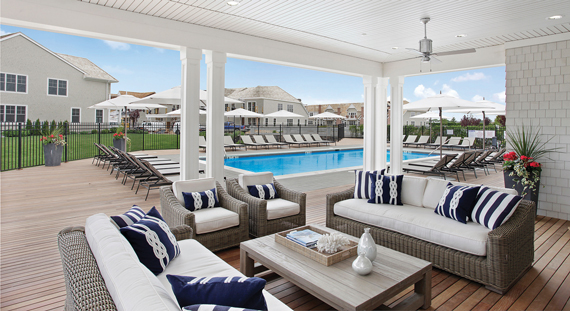Trending
Beechwood doubles down
The father-and-son duo of Michael and Steven Dubb have built the largest residential housing development firm on Long Island

Michael Dubb, the founder and CEO of the Beechwood Organization — the largest developer of residential housing on Long Island — aspired to become a builder at an early age. Born 60 years ago in East Williston in Nassau County, Dubb began his career by starting a landscaping business straight out of high school. He said that as a teenager pushing a lawn mower, he was making his money “a dollar at a time.”
But he had his eye on bigger things, and his job prospects rapidly improved. While still in his twenties, he applied for and received a bank loan for a small construction project in Nassau County’s East Meadow. Based on the success of this 18-house development, he was able to finance another project in North Hills, also in Nassau County, which generated about $50 million in revenue.
In the 1980s, he went on to work in New York City’s affordable housing program, an experience he still remembers fondly. “When I see kids getting off the school bus and going up into their rooms, and the rooms I’ve built are the center of their universe, I get a great deal of pleasure,” Dubb said.
For the most part, he chooses to finance his projects through a combination of straight construction loans and the firm’s capital. “I’m not a fancy finance guy,” he said. Dubb attributes his conservative financial instincts to the fact that he has worked his way up from scratch.
Beechwood had revenues of $205 million in 2015, making it the 73rd-largest builder in the U.S., according to Professional Builder Magazine. “I’ve built over 6,000 homes,” Dubb told The Real Deal, “travelling on a parallel path of building affordable and luxury housing.”
Dubb clearly still takes pleasure in the building process. He showed up to a recent interview at his Jericho, New York, headquarters dressed in a T-shirt, jeans and heavy construction boots. “I was climbing in holes today,” he said.
 When he’s not on a construction site, Dubb spends a great deal of time managing his 80 thoroughbred racehorses and stables in New York’s Belmont and Saratoga, as well as some in Florida. He serves as a board member of the New York Racing Association and has been the most successful thoroughbred owner on the New York racing circuit — winning the most races at Aqueduct, Belmont and Saratoga — in four of the last six years.
When he’s not on a construction site, Dubb spends a great deal of time managing his 80 thoroughbred racehorses and stables in New York’s Belmont and Saratoga, as well as some in Florida. He serves as a board member of the New York Racing Association and has been the most successful thoroughbred owner on the New York racing circuit — winning the most races at Aqueduct, Belmont and Saratoga — in four of the last six years.
Dubb has chosen to shower some of his philanthropy on the racing community. He has been involved with the Belmont Childcare Association since its inception in 1998. In 2002, he built Anna House, a 7,500-square-foot day care center for the children of the backstretch workers at Belmont Park.
Going Condo
Recently, Dubb embarked on one of his most daring business moves yet. After years of building suburban homes — and affordable housing in Brooklyn, where he remembers wearing a bulletproof vest on site visits — he has kick-started several projects on the East End.
But what Beechwood is bringing to the Hamptons and its environs is not the typical oceanfront spread. So far, Beechwood’s East End portfolio has focused on condominiums and townhouses, which are obviously greatly outnumbered in the region by single-family homes.
“It’s a simple case of supply and demand,” Dubb said. “You have hundreds and thousands of homes in the Hamptons but very few condominiums.”
Bishops Pond Southampton Village — built on a former sand pit — was the firm’s first Hamptons development. Beechwood partnered with Long Island developer George Benedict on the project. Within 10 weeks of completing this 69-unit townhouse development in April 2013, the first 40 units had been sold. “Our very first buyers were year-round Hamptons people,” Dubb said. “They don’t want the responsibility of leaky roofs, cutting the grass or shoveling the show, but they want to stay in the community.”
The development was so popular that Beechwood expanded it with 10 additional townhomes on an adjacent piece of property called the Enclave at Bishops Pond in 2015. The addition shares an entrance and is fully integrated with Bishops Pond. The National Association of Homebuilders honored Bishops Pond with three awards in 2015, including “best attached community of the year.”
While condos and townhouses represent about 6 percent of the Hamptons housing market, the average price skyrocketed 76 percent over the three years ending in 2015, according to the real estate appraisal firm Miller Samuel. By way of comparison, the average sales price of single-family homes was 8 percent lower over the same time period.
“The condo numbers surged because there was a significant shift in the mix to higher-end quality product in 2015, ” said Jonathan Miller, the president and CEO of Miller Samuel, while noting that the numbers for that segment are much more vulnerable to skew because it is so small. He added that condos and townhouses appeal to many urbanites who like the idea of owning a vacation home but are unwilling to do yard work and are “predisposed to condominium living.”
Dubb’s 30-year-old son, Steven, oversees the Hamptons portfolio. “I fell into this business at birth,” he said.

The clubhouse at Bishops Pond Southhampton Village
Both father and son are trying to navigate a middle way in the Hamptons, between the multi-million-dollar custom homes by the likes of Joe Farrell and some big high-end condo projects, such as the 64-unit Watchcase Factory in Sag Harbor by Cape Advisors. Steven said he did not see the Cape Advisors project as direct competition to Beechwood’s condo and townhouse units in the area. “It’s generally a higher price point and a different style of living from what we sell,” he said.
For his part, Craig Wood — Cape Advisors’ co-founder and co-managing partner — said the former Bulova watchcase factory building, located at 15 Church Street, was an “irreplaceable asset” in Sag Harbor. The Manhattan-based developer has sold 80 percent of the units since the building opened in 2014. Wood agrees with the Dubbs on the commercial potential for new condominium and townhouse developments in the area. “People want to be out east,” he said, without having to worry about the time or money needed to maintain large houses or gardens.
Judi Desiderio of Town & Country Real Estate said the new condos were an appealing option to many baby boomers. “They’re getting older and retiring and want to split their time between the Hamptons and somewhere else,” she said. “Condo living lends itself to that kind of lifestyle.”
Yet Desiderio said that over the long run, single-family homes tended to appreciate more than condominiums or townhouses.
New Homesteads
Despite their fervor for condos and townhomes, the Dubbs are also involved in the construction of single-family homes in the Hamptons and surrounding area.
In 2014, they opened Beechwood Highlands, a 28-unit development of single-family homes in Riverhead, on the North Fork. As of June, there were just two units remaining. “I thought it was exciting to build accessible housing in such a beautiful setting,” Steven said. “The North Fork is just stunning and has even better vistas than the Hamptons.”
In 2016, Beechwood completed the first homes at Bishops Grant, a luxury four-house subdivision at the intersection of North Main Street and County Road 39A in Southampton. Each of the seven-bedroom, six-and-a-half bathroom, 6,500-square-foot homes sits on an acre of land and is priced around $4.5 million. Two of the four homes have been sold. Another home has been finished, and the fourth is expected to be completed in 2017.
In early 2016, Beechwood — once again in partnership with Benedict — bought the iconic Village Latch Inn Hotel situated on a five-acre site in Southampton Village for $23 million. The 25,000-square-foot, 67-room hotel first opened in 1901. Steven, who is a resident of nearby Amagansett, said that they were still mulling over what to do with the former inn. He was certain that they would not reopen it as a hotel and said they would most likely convert it to a residential property.
Although the Village Latch Inn, which is located at 101 Hill Street, is not a designated landmark, Steven told TRD that he was committed to preserving the essential character of the façade and would work to restore the building to its former glory.




